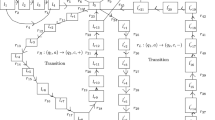Abstract
In spite of wide investigations of finite splicing systems in formal language theory, basic questions, such as their characterization, remain unsolved. In search for understanding the class of finite splicing systems, it has been conjectured that a necessary condition for a regular language L to be a splicing language is that L must have a constant in the Schützenberger’s sense. We prove this longstanding conjecture to be true. The result is based on properties of strongly connected components of the minimal deterministic finite state automaton for a regular splicing language.
Access this chapter
Tax calculation will be finalised at checkout
Purchases are for personal use only
Preview
Unable to display preview. Download preview PDF.
Similar content being viewed by others
References
Berstel, J., Perrin, D.: Theory of Codes. Academic Press Inc., Orlando (1985)
Bonizzoni, P., De Felice, C., Mauri, G., Zizza, R.: Regular Languages Generated by Reflexive Finite Linear Splicing Systems. In: Ésik, Z., Fülöp, Z. (eds.) DLT 2003. LNCS, vol. 2710, pp. 134–145. Springer, Heidelberg (2003)
Bonizzoni, P., De Felice, C., Zizza, R.: The structure of reflexive regular splicing languages via Schützenberger constants. Theoretical Computer Science 334(1-3), 71–98 (2005)
Bonizzoni, P., Mauri, G.: Regular splicing languages and subclasses. Theoretical Computer Science 340, 349–363 (2005)
Bonizzoni, P.: Constants and label-equivalence: A decision procedure for reflexive regular splicing languages. Theoretical Computer Science 411(6), 865–877 (2010)
Bonizzoni, P., Jonoska, N.: Splicing languages and constants, manuscript (2011)
Černý, J.: Poznámka k homogénnym eksperimentom s konecnými automatami. Matematicko-fyzikalny Časopis Slovenskej Akadémie Vied 14, 208–216 (1964)
Culik, K., Harju, T.: Splicing semigroups of dominoes and DNA. Discrete Applied Math. 31, 261–277 (1991)
De Luca, A., Restivo, A.: A characterization of strictly locally testable languages and its application to semigroups of free semigroup. Information and Control 44, 300–319 (1980)
Goode, E.: Constants and splicing systems, PHD Thesis, Binghamton University (1999)
Goode, E., Pixton, D.: Recognizing splicing languages: Syntactic Monoids and Simultaneous Pumping. Discrete Applied Mathematics 155, 989–1006 (2007)
Head, T.: Formal Language Theory and DNA: an analysis of the generative capacity of specific recombinant behaviours. Bull. Math. Biol. 49, 737–759 (1987)
Hopcroft, J.E., Motwani, R., Ullman, J.D.: Introduction to Automata Theory, Languages, and Computation. Addison-Wesley, Reading (2001)
Jonoska, N.: Sofic Systems with Synchronizing Representations. Theoretical Computer Science 158(1-2), 81–115 (1996)
Lind, D., Marcus, B.: An Introduction to Symbolic Dynamics. Cambridge University Press, New York (1995)
Paun, G.: On the splicing operation. Discrete Applied Math. 70, 57–79 (1996)
Paun, G., Rozenberg, G., Salomaa, A.: DNA computing, New Computing Paradigms. Springer, Berlin (1998)
Pixton, D.: Regularity of splicing languages. Discrete Applied Math. 69, 101–124 (1996)
Schützenberger, M.P.: Sur certaines opérations de fermeture dans le langages rationnels. Symposia Mathematica 15, 245–253 (1975)
Verlan, S.: Head systems and applications to bio-informatics. Ph. D. Thesis, University of Metz (2004)
Author information
Authors and Affiliations
Editor information
Editors and Affiliations
Rights and permissions
Copyright information
© 2011 Springer-Verlag Berlin Heidelberg
About this paper
Cite this paper
Bonizzoni, P., Jonoska, N. (2011). Regular Splicing Languages Must Have a Constant. In: Mauri, G., Leporati, A. (eds) Developments in Language Theory. DLT 2011. Lecture Notes in Computer Science, vol 6795. Springer, Berlin, Heidelberg. https://doi.org/10.1007/978-3-642-22321-1_8
Download citation
DOI: https://doi.org/10.1007/978-3-642-22321-1_8
Publisher Name: Springer, Berlin, Heidelberg
Print ISBN: 978-3-642-22320-4
Online ISBN: 978-3-642-22321-1
eBook Packages: Computer ScienceComputer Science (R0)




